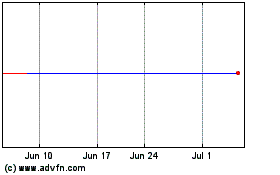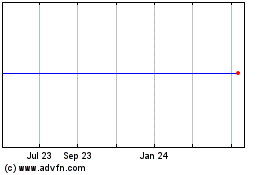Hancock Jaffe Laboratories, Inc. (Nasdaq: HJLI, HJLIW), a Company
specializing in medical devices that restore cardiac and vascular
health, today announced end-points for its upcoming VenoValve
first-in-human study in Bogota, Colombia. Endpoints for the study
will include improvements in reflux time, as well as rVCSS, VAS and
VEINES scores, three well known clinical measurements for venous
disease. Patients will be monitored at regular intervals
during the study with the 90 day and 180 day results being of
particular importance to the Company and the U.S. Food and Drug
Administration (“FDA”). Knowledge gained from the Colombian study
will be used to make any necessary design modifications to the
VenoValves in preparation for the Company’s U.S. pivotal trial.
Duplex scans will be administered to measure
reflux time - the duration of reflux in the deep venous system.
Reflux occurs when a series of one-way valves in the leg begin to
fail, resulting in the backflow of blood. A duplex scan, also known
as a doppler test with ultrasound, is a non-invasive evaluation of
blood flow through veins and arteries and is the mainstay for
evaluating chronic venous insufficiency (“CVI”). On average,
patients without CVI have reflux times of about 1 second, with
reflux times increasing with the increasing severity of the
disease. Improvements in reflux times will be expressed as a
percentage of the original duplex measurement.
The rVCSS is used to measure changes in venous
disease severity and response to treatment and includes ten
descriptors or subcategories of venous disease which are rated from
0 to 3 by the clinician. Once an initial baseline rVCSS is
established for each patient, changes in rVCSS scores will be
tracked and may be expressed as a percentage change from the
original or previous scoring.
The VAS or Visual Analogue Scale is widely used
in clinical research to measure intensity and frequency of pain.
Scores are marked along a continuum between “no pain” and
“worst pain”.
VEINES is a disease specific, quality of life
measurement associated with venous ulcers. The VEINES instrument
consists of 35 items in two categories that generate two summary
scores: a quality-of-life questionnaire (VEINES-QOL) comprising of
25 items that quantify disease effect on quality of life; and a
symptom questionnaire (VEINES-Sym) which consists of 10 items that
measure physical symptoms. In addition to being painful, prone to
infection, and hampering mobility, venous ulcers are known to
impact work capacity, social activity, self-care and personal
hygiene, and to cause depression, anxiety, and social
isolation.
On December 17, 2018, HJLI announced that it had
received approval for its first-in-human trial from INVIMA, the
Colombian equivalent of the FDA. The Company is making arrangements
to import the VenoValves to Colombia, and has begun to screen
patients for the study.
"We have already received more than 100
inquiries from patients in Colombia wanting to participate in our
study,” said Robert Berman, Hancock Jaffe’s CEO. “Patients will be
carefully screened under the supervision of Dr. Jorge Hernando
Ulloa, our primary investigator in Bogota, and Dr. Marc H.
Glickman, Hancock Jaffe’s Chief Medical Officer. Because
results from the study will come relatively quickly, now is the
appropriate time to begin to explain the terminology that we will
be using to measure our success.”
Once initial patient enrollment is completed,
HJLI will announce the expected date for the first VenoValve
implantations. The Company expects to provide another update
shortly after the first implantations, and a further update part of
the way through the study after compiling sufficient preliminary
data. Following the completion of the 6 month study, the Company
will seek to present its data at worldwide vascular conferences and
publish the data in a peer reviewed journal.
Patients will have follow-up visits and
assessments approximately 14 days, 30 days, 60 days, 90 days, and
180 days after implantations of the VenoValves. HJLI will monitor
patients for potential serious adverse events related to the
device, which include thromboses (blood clots) leading to
obstruction, stenosis (narrowing) of the vein, inflammation
(neointimal hyperplasia) leading to device failure, device
migration, bleeding due to native vein injury or anticoagulation,
and infection.
The first-in-human Colombian study will
initially include 5 to 10 patients who suffer from severe CVI, a
condition that occurs when the valves in the veins of deep venous
system of the leg are injured or destroyed, causing blood to pool
in the lower extremities. Severe CVI often includes swelling,
debilitating pain, and skin ulcerations that become ongoing, open
wounds. The VenoValve is a potential treatment and cure for severe
CVI, a condition that effects approximately 4.5 million people in
the U.S. and tens of millions of additional patients worldwide.
There are currently no FDA approved treatments for deep venous
CVI.
About Hancock Jaffe Laboratories, Inc.
HJLI specializes in developing and manufacturing
bioprosthetic medical devices to establish improved standards of
care for treating cardiac and vascular diseases. HJLI currently has
three product candidates: the porcine tissue based VenoValve®,
which is intended to be surgically implanted in the deep venous
system of the leg to treat Chronic Venue Insufficiency; the
CoreoGraft®, a bovine tissue based off the shelf conduit intended
to be used for coronary artery bypass surgery, and a porcine tissue
based heart valve, which based upon its relatively small size and
increased output, is an ideal candidate for pediatric aortic/mitral
valve replacement.
Cautionary Note on Forward-Looking
Statements
This press release and any statements of
stockholders, directors, employees, representatives and partners of
Hancock Jaffe Laboratories, Inc. (the “Company”) related thereto
contain, or may contain, among other things, certain
"forward-looking statements" within the meaning of the Private
Securities Litigation Reform Act of 1995. Such
forward-looking statements involve significant risks and
uncertainties. Such statements may include, without
limitation, statements identified by words such as "projects,"
"may," "will," "could," "would," "should," "believes," "expects,"
"anticipates," "estimates," "intends," "plans," "potential" or
similar expressions. These statements are based upon the
current beliefs and expectations of the Company’s management and
are subject to significant risks and uncertainties, including those
detailed in the Company’s filings with the Securities and Exchange
Commission. Actual results (including, without limitation,
the performance of the new board members described herein) may
differ significantly from those set forth or implied in the
forward-looking statements. These forward-looking statements
involve certain risks and uncertainties that are subject to change
based on various factors (many of which are beyond the Company’s
control). The Company undertakes no obligation to publicly
update any forward-looking statements, whether as a result of new
information, future presentations or otherwise, except as required
by applicable law.
HJLI Press Contacts:
Amy CarmerTel: 949-261-2900Email: ACarmer@HancockJaffe.com
Hancock Jaffe Laboratories (NASDAQ:HJLI)
Historical Stock Chart
From Dec 2024 to Jan 2025

Hancock Jaffe Laboratories (NASDAQ:HJLI)
Historical Stock Chart
From Jan 2024 to Jan 2025
